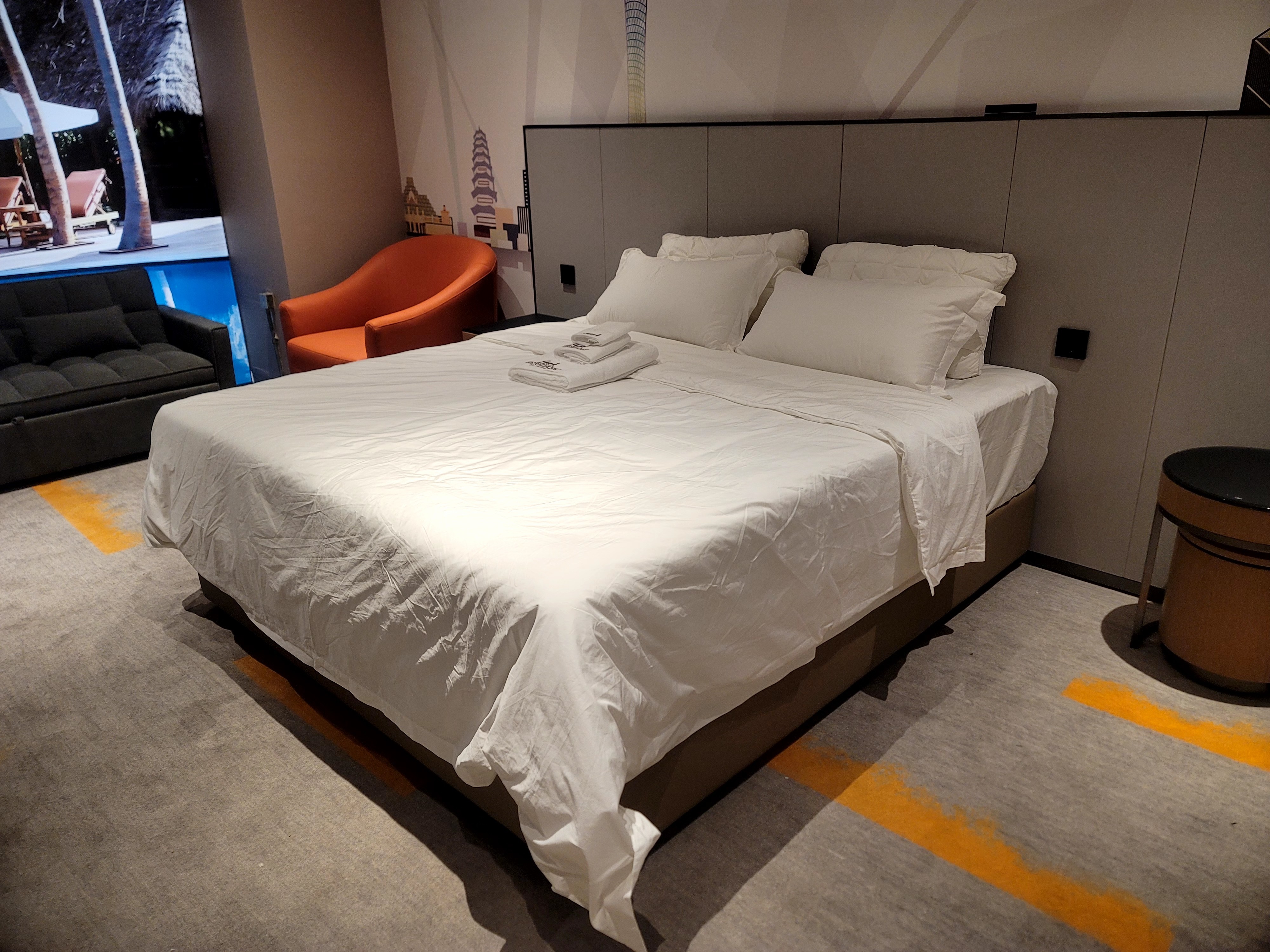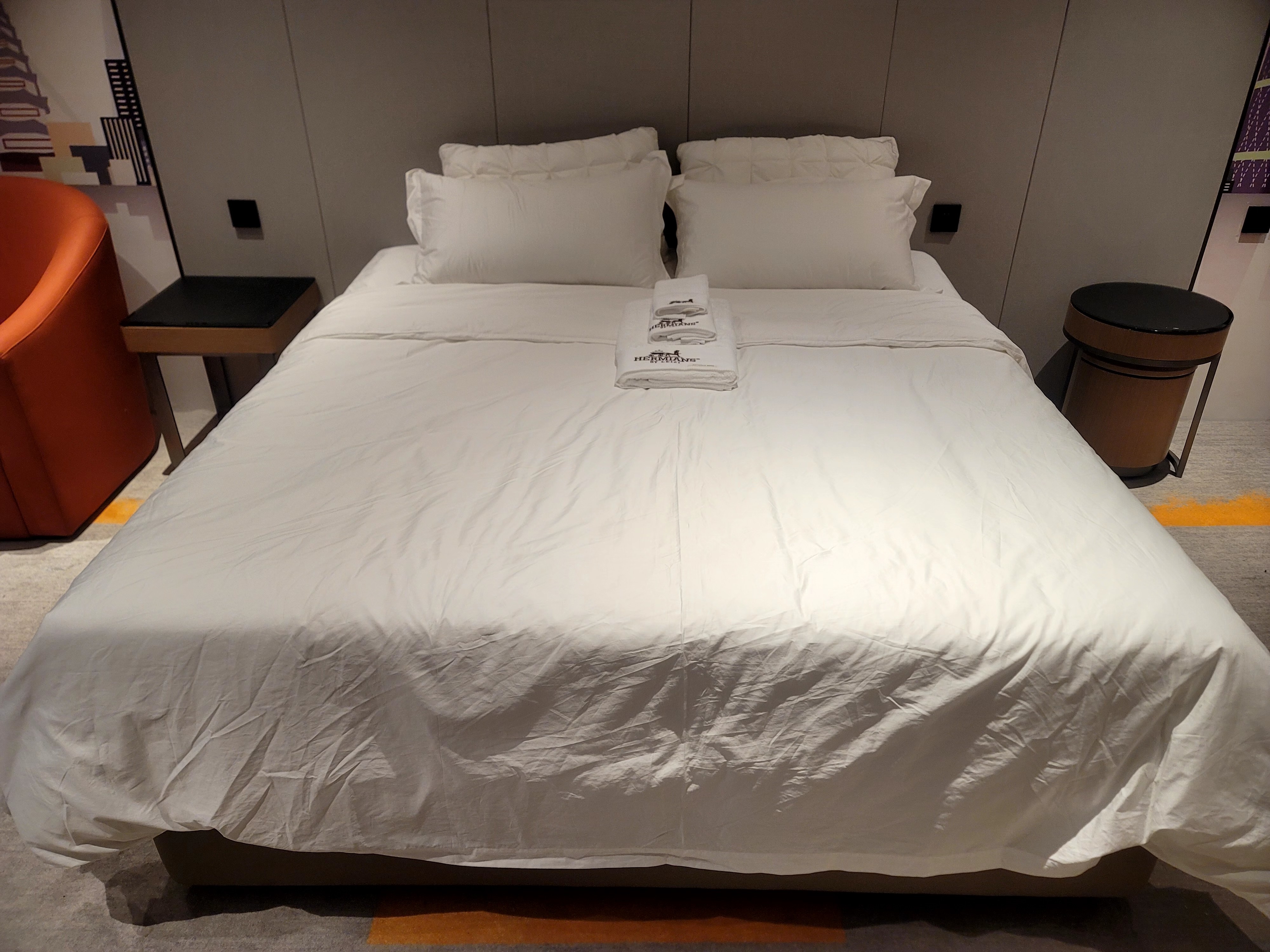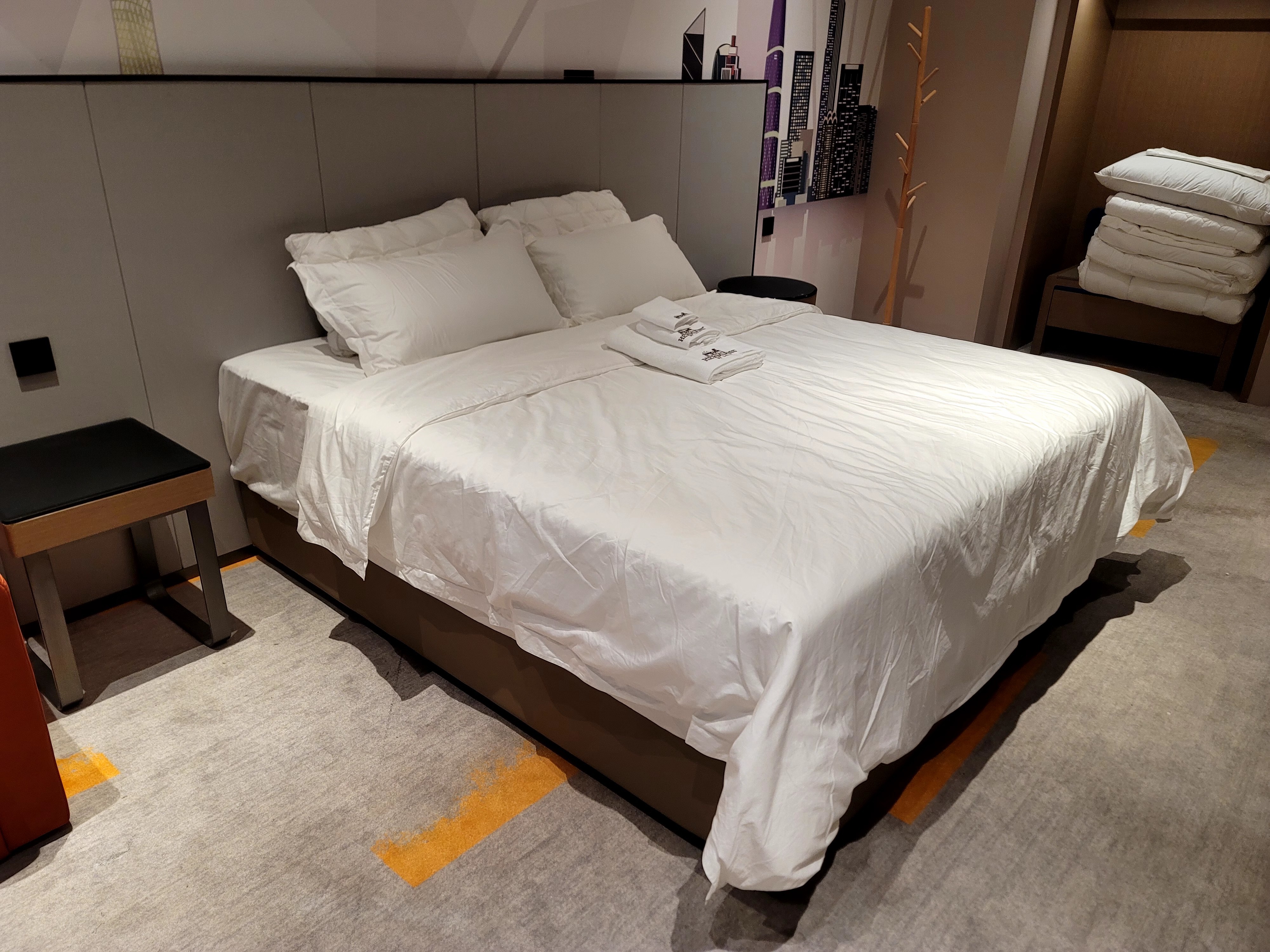26
2025
-
08
What are TC, Thread Count, and GSM? Learn fabric specifications in one minute to avoid pitfalls when choosing fabrics!
Category:
【Brief Description】Whether you're purchasing linens for a hotel, renovating guest rooms, or replacing bedsheets and quilt covers at home, the mere sight of specifications can be overwhelming—what are TC, thread count, and GSM? Confused and worried about buying the wrong fabric? Don't worry, we'll explain everything here so you can confidently choose your linens and avoid wasting money!
What are TC, Thread Count, and GSM? Learn fabric specifications in one minute to avoid pitfalls when choosing fabrics!
Whether you're purchasing linens for a hotel, renovating guest rooms, or replacing bedsheets and quilt covers at home, the mere sight of specifications can be overwhelming—what are TC, thread count, and GSM? Confused and worried about buying the wrong fabric? Don't worry, we'll explain everything here so you can confidently choose your linens and avoid wasting money!

Understand at a glance—A quick guide to the concepts of three key indicators (TC, Thread Count, and GSM)
Don't be overwhelmed when choosing linens; just remember these three terms! TC refers to the composition ratio, thread count determines the fineness of the hand, and GSM directly tells you the thickness of the fabric. Once you understand these, choosing bedding and towels will be as straightforward as a seasoned buyer, and data sheet pages won't scare you anymore!
What is TC?
TC simply stands for "polyester-cotton blend," referring to the ratio of polyester (T) to cotton (C). For example, the 65/35 blend commonly used in hotels is 65% polyester and 35% cotton. This blend is durable and wrinkle-resistant, retains its shape even after frequent washing, and is suitable for hotels where clothing is frequently washed. An 80/20 blend, with less cotton and more polyester, is stronger but less breathable. Pure cotton (e.g., 100% cotton) is breathable and comfortable to sleep on, but it wrinkles easily and requires regular care for household use.
What is the thread count?
Think of the yarn count as the "fineness" of the yarn. The higher the count, the finer the yarn and the smoother it feels. For example, a 40-count yarn is finer and denser than a 30-count yarn, while a 60-count yarn is even smoother and more lustrous. For general household use, a 40-60-count yarn is quite sufficient. Don't blindly choose yarn based solely on the number; some yarns with too high a count may not last long. For general household use, a 40-60-count yarn is the most practical.
What is GSM?
GSM stands for grams per square meter, or simply "fabric thickness." The higher the number, the thicker and more durable the fabric. For example, bed sheets typically range from 120–200 GSM, with the closer to 200, the firmer they feel. Towels, on the other hand, range from 400–700 GSM, with anything above 500 considered thick and absorbent. Don't assume heavier is better; a moderate weight is key. High GSM fabrics can be stuffy in the summer, though.
How to Understand Fabric Specification Sheets? — Step-by-Step Guide
When you buy linens, you receive a data sheet with information like TC, count, and GSM. Don't panic! We'll break it down one by one and guarantee you'll understand the ropes. You won't be fooled by anything you buy!

Look at the proportions (TC, TR, TM... what do they mean?)
The abbreviations TC, TR, and TM actually refer to the ratio of materials used in the fabric.
Take the most common TC (polyester-cotton) mix, for example. TC 65/35 is 65% polyester + 35% cotton. This ratio is wrinkle-resistant and easy to care for, and is most commonly used in hotel linens. It's durable and durable even without washing. TC 80/20, with a higher content of polyester, is stronger but slightly less breathable, making it suitable for areas that see frequent use and washing. Remember:
More cotton is more comfortable, but also more prone to wrinkling; more polyester is more durable, but also has a stiffer feel.
Look at the number of sticks (30s, 40s, 60s... which one is the best to choose?)
The yarn count indicates the fineness of the yarn. The higher the count, the finer the yarn, resulting in a softer and denser fabric.
Note this in your notebook:
|
Number of pieces |
Yarn Thickness |
Features: |
Recommended Uses |
|
30s |
Coarse |
Solid, slightly rough |
Budget hotel/dormitory bedding |
|
40s |
Medium |
Soft, good value |
Preferred home sheets and duvet covers |
|
60s↑ |
Thin |
Smooth and shiny |
High-end home/star hotel bedding |
Generally, 40 to 60 sticks are sufficient for home use. If you go higher, it would be a bit wasteful and delicate for daily use.
Look at GSM (high weight = good quality? That’s not necessarily true!)
GSM refers to the grams per square meter of fabric, which simply means "is this fabric thick or sturdy?"
But don't blindly chase high weights—too high will cause you to sweat when lying on it, and it will take longer to dry after washing; too low will make it thin, breathable, and less durable.
For example:
Sheets: 120–160 GSM is considered light and thin, while 180–200 GSM is moderately sturdy;
Towels: 400–500 GSM is highly absorbent, while 600–700 GSM is thicker but dries slower.
So, choosing a GSM depends on the intended use. Heavier isn't always better. Finding a balance between comfort, durability, and practicality is key!
Fabric real chestnuts are here! See how these specifications are used
Knowing the specifications isn't enough; you also need to be able to match them to your actual needs! We've found a few common linen specifications on the market and explained their properties and their ideal applications in plain English. After reading these examples, you'll have a basic understanding!
|
Specification |
Feel |
Advantages |
Disadvantages |
Recommended Use Cases: |
|
TC 65/35 40s 180GSM |
Moderately soft and firm, solid |
Durable and washable, attractive price |
Not as breathable as pure cotton |
Budget Hotels/High-Frequency Laundry |
|
TC 80/20 40s 160GSM |
Slightly hard, wear-resistant |
Extremely durable, no pilling |
Feels slippery and generally breathable |
School Dormitories/Long-Term Rental Apartments |
|
100%棉 60s 200GSM |
Soft and smooth against the skin |
Breathable and comfortable, premium quality |
Wrinkles easily, a bit pricey |
Home Use/Boutique B&Bs |
|
100%棉 80s 300GSM |
Delicate and shiny |
High-quality sleeping experience, a touch of class |
Expensive, requires careful care |
Star-Rated Hotels/Gifts/Personal Use |
|
100%棉 20s 500GSM |
Thick and furry |
Highly absorbent, durable |
Dries slowly, bulky |
Bathroom Towels/Bathrobes |
Let's take a look at two examples:
For example, if you see "TC 65/35 40s 180GSM": This combination is durable and washable, and it's affordable. It's a perfect choice for hotel room sheets and duvet covers, and they won't lose their shape even after daily washing!
If it says "100% Cotton 60s 200GSM": Wow, this is so soft and comfortable to sleep on. Whether you use it at home or run a budget-friendly B&B, your guests will definitely praise you for buying it!
Remember:
There's no "best" linen, only the "most suitable" configuration. For frequent use, durability is key; for home use, comfort is key; and for high-end spaces, quality is key. After reviewing this chart, you'll be able to flexibly choose your next purchase based on the specific situation!
Don't fall into pitfalls when buying linens! These tips will help you avoid pitfalls and save money
When choosing linen, don't just listen to the hype! Does a higher thread count always mean better? Does a heavier GSM mean stronger? Does a higher TC ratio mean stronger? Let's address some of the most common misconceptions. We guarantee you'll avoid wasting money and make informed, effective purchases.
❌ Misconception 1: Only looking at the thread count, regardless of the weave
A high thread count does indeed give a delicate feel, but if the weave is not good (for example, a plain weave instead of a satin weave), even a high thread count will be prone to snagging and lack texture. High-quality linen requires a good combination of thread count and weave to achieve its desired effect!
❌ Misconception 2: Thinking the higher the GSM, the better
A high GSM ratio only means the fabric is thicker, not necessarily comfortable. Too heavy a weight will cause you to sweat while sleeping and make it difficult to dry after washing, especially in the humid southern regions. Blindly chasing a high weight is highly recommended.
❌ Misconception 3: The higher the TC content, the better
Higher polyester content improves durability, but reduces breathability and creates a slippery feel, unlike pure cotton. Generally, a 65/35 ratio strikes a balance between durability and comfort. Any higher and you lose the comfort of cotton.
✅ How to avoid a bad choice? Simply copy the homework based on the intended use:
High-traffic hotels/guesthouses: Recommend the TC65/35 40s 170-180gsm. It's durable and wear-resistant, and won't rot even after daily washing!
For a light luxury homestay/home upgrade: Choose the 100% cotton 60s 200-220gsm. It's soft and breathable, classy without being too delicate.
For a cost-effective everyday home: Choose the TC80/20 40s 160gsm or the pure cotton 40s. They're washable and comfortable, and you'll have years of use without regrets.
Don't choose the expensive, choose the right one! Understand the specifications and consider the specific use case, and you'll be a linen expert!
Washing it right makes it last longer! If you want your linens to last longer, you need to take care of them this way.
Rubbing linens harder doesn't guarantee they'll get cleaner. Even the finest fabrics can be ruined if you don't do it right! Remember these tips to get a clean wash without damaging the fabric:
Don't overheat: 40-60°C is generally fine for cotton-polyester blends, and don't exceed 80°C for pure cotton. Burning and shrinking the fabric won't be worth it.
Don't overuse detergent: Neutral detergents are best. Avoid strong alkaline or acidic ones. Use less bleach, as the colors will wilt with each wash.
Don't overheat the dryer: Use medium-low heat. Excessive bleaching can make fabric stiff and prone to pilling.
Always read the care label: Don't worry if you don't understand the icons; just look for the instructions and follow them for sure!
Treating your laundry properly will give it two years of extra service—it's worth it no matter how you look at it!

FAQ — All your questions answered here
Q: What does TC mean?
A: TC refers to the blend ratio of polyester and cotton. For example, TC 65/35 means 65% polyester and 35% cotton, with the higher the count, the greater the percentage of the component.
Q: Is a higher thread count better?
A: Absolutely not! While a higher thread count is smoother, it's also more delicate. If the weave isn't good, it won't last as long. Generally, 40-60 thread count is ideal for home use.
Q: Does a higher GSM count mean the fabric is thicker?
A: Generally, a higher GSM count means thicker fabric, but thickness also depends on the weave. Some fabrics have a looser weave and a higher weight, but they aren't necessarily stronger.
Q: Which is better, pure cotton or polyester cotton?
A: There's no absolute winner! Pure cotton is breathable and comfortable, but it wrinkles easily, while polyester cotton is durable and easy to care for. It depends on what you value most.
Q: Why is pure cotton rarely used in hotel linens?
A: Because hotels wash and clean their bedding daily, pure cotton wrinkles and wears easily after frequent washing. Polyester-cotton blends are more durable and washable, saving both time and money.
Q: Why do bedding lose its shape after just a few washes?
A: Most likely it's due to using the wrong detergent, using too high a water temperature, or drying too harshly. It has to do with both the fabric itself and how you care for it.

